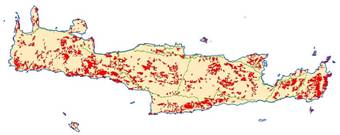Resource uses and existing land practices
Resource uses
Based on the statistical data (Green National Statistical Service) the agricultural areas including farmland and pastures cover 594,740 ha or 71.5% of the total area (Table 2). Natural areas (forests, shrubs and bare land) covers 225,080 ha or 27.1% of the total land. Other areas including urban, infrastructure, mining etc, cover 1,1180 ha or 1.4% of the total area. More information about land use is mentioned above.

Table 2: Land resources use of Crete study site
Pastures are extended in a wide range of altitudes from low to alpine zones. They can be distinguished in the three following zones based on altitude: (a) pastures of low zone (altitude 0-600 m), (b) pastures of middle zone (altitude 600-800 m), and (c) pastures of upper zone (altitude >800m) (Sarlis, 1998). As Figure 9 shows pastures are widely expanded all over the island. In many cases agricultural land is used for grazing animals too.
Pastures are found in all climatic conditions existing in Crete which cannot be characterized as favourable for high grass production. The long duration of drought in summer and the low temperatures prevailing during winter restricts plant growth. Therefore, natural pastures can be used for grazing a short period during winter, spring or fall but never during the whole year. Pastures are found in most parts of the island of Crete especially in hilly and mountainous areas.
Figure 9: Geographical distribution of natural pastures in Crete according to CORINE 2000
Existing land practices
Land management practices can be distinguished in those applied in agricultural land and those in pasture land. The trends in land management practices existing in the agricultural areas of Crete, resulting from a recent survey in the area, can be summarized as following:
- Keeping with minimum cost of citrus plantations or replace them with avocado since prices has declined in the recent period
- Keeping olive plantations under minimum or no tillage operations in the western part of the island
- Ploughing the soil in olive groves once or twice during spring period especially in the central and eastern part of the island.
- Expanding olive plantations especially in the upper hilly areas by clearing natural vegetation and applying intense cropping systems
- Abandonment olive groves in steep soils of low productivity allowing the natural vegetation to be growing and using the land as pasture which is usually overgrazed
- Planting some vineyards in relatively productive soils applying intensive cultivation
- Shift from agricultural land use to urban or tourist development especially in the area along the coast
- Reduce irrigation in citrus plantations and olive groves due to limited water availability and loss in farm income.
Land management analysis conducted in the region of Chania has shown that the majority of the land (70.5% of the total area) is subjected to sustainable farming by allowing understory vegetation to grow during the wet period. Oxalis pes-caprae is the main plant species growing under olives, citrus and avocado fully protecting the soil from raindrop impact. Oxalis is considered as a weed but it has a positive effect on soil and water conservation. In the rest of the land (26.5% of the total land) covered by olives vines and vegetables sustainable farming is not applied. The practice of no sustainable farming is mainly found in the northern part of the study area in places where soils are deep with lower slope gradients. In the opposite, olive groves in the Messara valley are subjected to tillage operations once or twice during spring time. The main reason for tilling the soil is water conservation by (a) removing the growing annual vegetation and (b) interrupting soil water loss due to evaporation from the subsurface layers.
Land management practices on pastures are affected by the physical environment (topography, altitude, soil depth, etc) and socio-economic characteristics (subsidies, family size, area of grazing land, etc). Pastures located in the upper zone (altitude >800 m) are used only during the summer period, all the others are used during the whole year. Overgrazing is very common resulting in high erosion rates and disappearance of various plant species and expansion of plant species which are not eaten by the animals. Furthermore, pastures in the upper zone receive large numbers of animals during the summer period or these pastures are undergrazed due to lack of infrastructure (roads and drinking water for the animals). Transhumance grazing systems operates at a variety of special and temporal scales and degrees of complexity. Animals can be daily moved from hills to valleys, or seasonal in mountains for summer grazing. The high stocking rates, the pastoral techniques employed and the frequent fires had led to a significant decline of pasture quality and productivity and an increase to of the proportion of unpalatable plant species.
Pastures in the lower zone covering plain and hilly areas (altitude lower to 600 m) are used mainly during the winter period or most of the year. Due to relatively favorable air temperatures, grass growth is mainly dependent on the amount of rainfall. Grass production is greater in spring than in fall but due to lack of water plants are getting dry quickly and animals are moving to upper elevations. Pastures in the middle zone (600-800 m) are grazed mainly by goats during the whole year. Grass production in the middle zone is especially high during spring, while grazing can be limited for some period during winter due to the presence of snow. Pastures of the upper zone are used for few months during summer. This zone is better protected from overgrazing and soil erosion.
